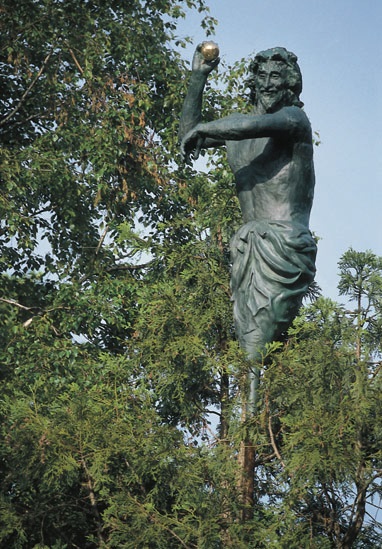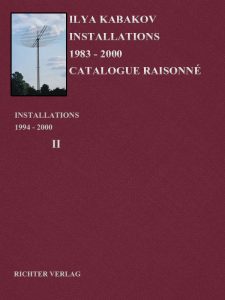The Golden Apples
with Emilia Kabakov
YEAR: 2000
CATALOGUE NUMBER: 151
PROVENANCE
Collection of the artist
Collection of the City of Hohentwiel, permanent installation
EXHIBITIONS
Kunst in Singen, Germany
Hier Da und Dort, International project ‘Kunst im öffentlichen Raum,’ 5 May 2000 — 8 Oct 2000
CONCEPT AND DESCRIPTION OF THE INSTALLATION
Directly after entering the park, the viewer sees a large bronze woven basket in the center of the lawn on the green grass. Apples are being gathered in this basket after the harvest. And the basket really is half-filled with apples, many other apples are lying all over the place near the basket on the grass. The apples are large and gilded on the outside, which makes them stand out clearly against the green grass of the lawn. The question involuntarily arises: the significance of this basket is unclear, why are some of the apples inside and the rest are outside?
But when the viewer lifts his head, he sees that there are three male figures clearly visible against the bright sky in the tops of the three trees closest to this spot. Each of these figures is in a vivid dynamic pose, and in each one’s hand is a golden apple just like those in the basket and lying near it.
Despite the distance between the basket and the three figures, the viewer immediately ‘grasps,’ understands the connection between them. Furthermore, this ‘rupture’ in two places in the installation forms the fundamental plastic ‘intrigue’ and works to embody its subject. It functions like a riddle with an unexpected solution: here is why some of the apples are on the grass and others are in the basket; it’s because someone has managed to hit the basket, while others have missed.
The installation contains a well-known theme from the Bible: the scene of temptation with the ‘golden apple’. Adam took the apple without thinking, and the main thing was who gave him the apple. Hence, the sculpture contains both a parabolic and an ironically ‘edifying’ meaning: there are a lot of golden apples at your feet, but be careful picking them up so easily. Look around and a bit farther off: is it worth taking them from those who are hiding in the greenery of the treetops, wishing to remain unnoticed?
Adult viewers can easily understand the theme of the sculpture and tell it to children: the story of Adam and Eve and the apple, and the meaning of this episode from the Great Book that is important for us to remember today.
But of course, there are other associations that are more likely than biblical ones to come to mind when viewing this installation. The thing is, it was conceptualized as a classical park sculpture. The main thing is where the sculptors are to be located in the city of Singen. There is a park currently under reconstruction in the center of the city, where new trees and shrubs are being planted and the pathways are being redesigned. However, the main section of the old park will remain untouched, and it contains an island with enormous old trees and surrounding it on both sides by two arms of the quickly flowing river. This ancient section of the park is a beloved place for relaxation and strolling by the population of Singen, people who are quite conservative and well-balanced. It is very risky to place a permanent sculpture in a place that is so well loved by the citizens of the city. It is necessary not only to preserve the existing atmosphere that has reigned there for decades, but also to consider one very important circumstance – the sculptures that will be made now and the entire ensemble should look as if it was made long ago and that it has been standing here for a very long time already. And, of course, this entire concept must be connected with the notion of a ‘beautiful park.’ The tradition of a ‘beautiful park’ goes back to ancient European culture, to ancient Greek holidays and rich ancient mythology. Many sculptures of naiads, fauns, satyrs and other gods are erected in European parks precisely to preserve this tradition.
The installation The Golden Apples corresponds entirely and is based on this tradition of placing ancient sculptures in a park. The three bronze sculptures hide in the greenery of the trees, or more precisely, they are half hidden up to their waists. Hence they are executed and appear to be entirely traditional (true, in a slightly expressionist manner, like that of the popular ‘Rodin style’ of the end of the 19th Century). The plasticity of the movement is also familiar from typical park repertoire. What is unexpected and new in terms of the traditions of park sculptures is their location in a most unusual place – not behind trees and bushes on the normal horizon but in the very tops of the trees where it is not customary to place sculptures because of their weight. But this location in the treetops opens up entirely new possibilities for park sculpture. In the first place, these sculptures can be seen from a great distance since their silhouettes are very distinct against the sky, and in the second place, together they form a kind of ring inside of which the park visitor finds himself. In order to see these sculptures and to find them, the visitor must constantly turn his head, and as a result, all of the surrounding nature enters into his field of attention, not just the grass and flowerbeds, but also the beautiful trees in the park and the sky above his head. The world expands, becomes deeper, voluminous, and at the same time, mysterious, in a cheery way, of course, since the sky and the sun reflect in the polished surfaces of the golden apples, forming many shining dots.
Of course, there is one other circumstance that is worth anticipating when erecting these figures in the treetops. The trees can continue to grow upward, and will gradually cover the sculptures from below. Therefore, trees must be selected that either are already full grown, or that will grow very, very slowly. Fortunately, there are such trees in the park, such as the old ‘Thuya.’
Technical Realization
The basket is made (cast) of bronze (dimensions are on the sketch). It is affixed to a cement block underneath it that is not visible.
The apples are made of anodized steel, and are coated with a covering that imitates gold. There is a cement cube under each of them that is inserted into the ground.
The figures of the sculptures are made from fiberglass and should also look like old bronze. Each is affixed to a steel rod and mounted in a deep hole filled with concrete. The rod stands next to the trunk of a tree and is attached to it in a few places with soft splints, but the rod itself doesn’t touch the trunk. (The sketch indicates that the diameter of the rod is 5 cm, and it runs parallel to the tree trunk.) In this way, both the safety of the entire construction and of the trees are ensured.
The rods inside of two trees (both ‘Thuya’) will not be visible in summer or winter, since the ‘Thuya’ preserves its greenery all year. The rod inside of the ‘Berhanhorn’ will be visible in winter (this tree loses its crown), but this interferes with the aesthetic concept.
All three trees are already full-grown, and will not grow upward any further, and therefore they won’t conceal the figures.
Models of the sculptures – the three figures and the basket – will be made in New York. The realization of the originals will be completed in Germany at a place close to where the sculptures are to be located.
Images
Literature









